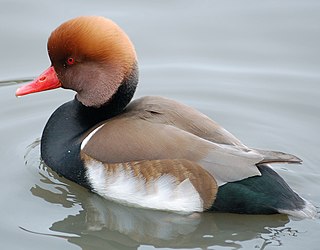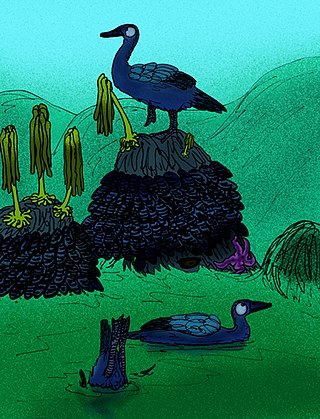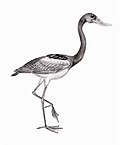
Duck is the common name for numerous species of waterfowl in the family Anatidae. Ducks are generally smaller and shorter-necked than swans and geese, which are members of the same family. Divided among several subfamilies, they are a form taxon; they do not represent a monophyletic group, since swans and geese are not considered ducks. Ducks are mostly aquatic birds, and may be found in both fresh water and sea water.

The Anatidae are the biological family of water birds that includes ducks, geese, and swans. The family has a cosmopolitan distribution, occurring on all the world's continents except Antarctica. These birds are adapted for swimming, floating on the water surface, and in some cases diving in at least shallow water. The family contains around 174 species in 43 genera.

Anseriformes is an order of birds also known as waterfowl that comprises about 180 living species of birds in three families: Anhimidae, Anseranatidae, and Anatidae, the largest family, which includes over 170 species of waterfowl, among them the ducks, geese, and swans. Most modern species in the order are highly adapted for an aquatic existence at the water surface. With the exception of screamers, males have penises, a trait that has been lost in the Neoaves. Due to their aquatic nature, most species are web-footed.

The diving ducks, commonly called pochards or scaups, are a category of duck which feed by diving beneath the surface of the water. They are part of Anatidae, the diverse and very large family that includes ducks, geese, and swans.

The Anatinae are a subfamily of the family Anatidae. Its surviving members are the dabbling ducks, which feed mainly at the surface rather than by diving. The other members of the Anatinae are the extinct moa-nalo, a young but highly apomorphic lineage derived from the dabbling ducks.

The Tadorninae is the shelduck-sheldgoose subfamily of the Anatidae, the biological family that includes the ducks and most duck-like waterfowl such as the geese and swans.

The gadwall is a common and widespread dabbling duck in the family Anatidae.
The term perching ducks is used colloquially to mean any species of ducks distinguished by their readiness to perch high in trees.

The knob-billed duck or African comb duck is a type of duck found along the tropical/sub-tropical wetlands and waterways of Sub-Saharan Africa and the island of Madagascar, as well as most of South Asia and mainland Indochina.

The comb duck or American comb duck, is an unusual duck, found in tropical wetlands in continental South America south to the Paraguay River region in eastern Paraguay, southeastern Brazil and extreme northeastern Argentina, and as a vagrant on Trinidad.

Anas is a genus of dabbling ducks. It includes the pintails, most teals, and the mallard and its close relatives. It formerly included additional species but following the publication of a molecular phylogenetic study in 2009 the genus was split into four separate genera. The genus now contains 31 living species. The name Anas is the Latin for "duck".

Aix is a bird genus that contains two species of ducks: the wood duck, and the mandarin duck. Aix is an Ancient Greek word used by Aristotle to refer to an unknown diving bird.

Netta is a genus of diving ducks. The name is derived from Greek Netta "duck". Unlike other diving ducks, the Netta species are reluctant to dive, and feed more like dabbling ducks.

Flightless birds are birds that, through evolution, lost the ability to fly. There are over 60 extant species, including the well-known ratites and penguins. The smallest flightless bird is the Inaccessible Island rail. The largest flightless bird, which is also the largest living bird in general, is the common ostrich.

The flying steamer duck, also known as the flying steamer-duck or flying steamerduck, is a species of South American duck in the family Anatidae.

The Chubut steamer duck or white-headed flightless steamer duck is a flightless duck endemic to Argentina.

The Falkland steamer duck is a species of flightless duck found on the Falkland Islands in the South Atlantic Ocean. The steamer ducks get their name from their unconventional swimming behaviour in which they flap their wings and feet on the water in a motion reminiscent of an old paddle steamer. The Falkland steamer duck is one of only two bird species endemic to the Falkland Islands, the other being Cobb's wren.

Chendytes lawi or Laws Duck is an extinct, goose-sized flightless marine duck, once common on the California coast, the California Channel Islands, and possibly southern Oregon. It lived in the Pleistocene and survived into the Holocene. It appears to have gone extinct at about 450–250 BCE. The youngest direct radiocarbon date from a Chendytes bone fragment dates to 770–400 BCE and was found in an archeological site in Ventura County. Its remains have been found in fossil deposits and in early coastal archeological sites. Archeological data from coastal California show a record of human exploitation of Chendytes lawi for at least 8,000 years. It was probably driven to extinction by hunting, animal predation, and loss of habitat. Chendytes bones have been identified in archaeological assemblages from 14 coastal sites, including two on San Miguel Island and 12 in mainland localities. Hundreds of Chendytes bones and egg shells found in Pleistocene deposits on San Miguel Island have been interpreted as evidence that some of these island fossil localities were nesting colonies, one of which Guthrie dated to about 12,000 14C years. There is nothing in the North American archaeological record indicating a span of exploitation for any megafaunal genus remotely as long as that of Chendytes.
Bradley Curtis Livezey was an American ornithologist with scores of publications. His main research included the evolution of flightless birds, the systematics of birds, and the ecology and behaviour of steamer ducks.
Philip Strong Humphrey was an ornithologist, museum curator, and professor of zoology.























